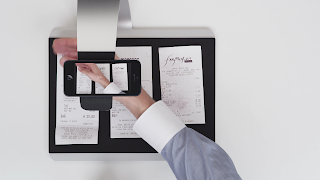Here’s a preview of an article that scheduled to run in tomorrow’s (Oct. 16) edition of DIR:
scanPAD is a German startup that has created a new apparatus designed to enable smartphones to act as document scanners, mini photo studios, and even overhead projectors. According to a press sheet, the scanPAD leverages patent-pending nanotechnology to hold and stabilize smartphones, as well as documents. Shaped like a desklamp (see image), the scanPAD holds a smartphone in place above whatever the user is trying to capture.
For documents, the base of the scanPAD has a microsuction surface designed to not only hold documents, but also smooth and flatten them. It is designed to work with whatever document capture app a user has installed on their phone. The reverse side of the microsuction pad features a bluescreen that enables users to take pictures with a transparent/replaceable background. The device can also be used to give video presentations utilizing printed pages or whiteboards.
The scanPAD carries a retail list price of 249 Euros, or about $283US. There is a Kickstarter campaign underway, with a goal of raising $113,000 over the next two months. As of mid-day yesterday, 40 backers had pledged $6,500. Pledges of a certain amount get the pledger a discounted scanPAD in return. Manufacturing is scheduled to begin in Germany in January with units to begin shipping in February.
I believe this is the third device we have covered in DIR designed to hold a smartphone to create higher quality scans. The last one was the Scandock from Atiz, a company headed by former Apprentice finalist Nick Warnock. Atiz’s Scandock lists for slightly more than the scanPAD but also offers a lighting system and software designed to ensure high-quality color images are produced.
Added for blog: Would it make sense for someone to create an ADF version of this type of scanner? Along those lines how fast could you capture images, say, leveraging the video camera within a smartphone or tablet? Could you do it ibml fast if you had the right transport? Just some food for thought.
